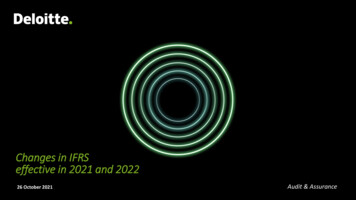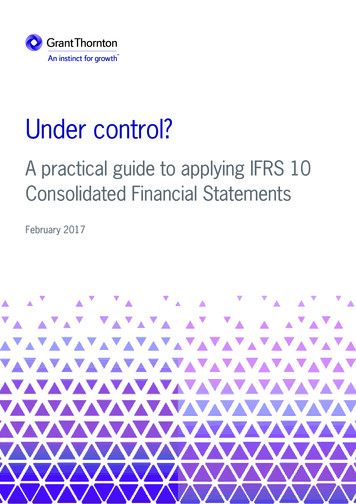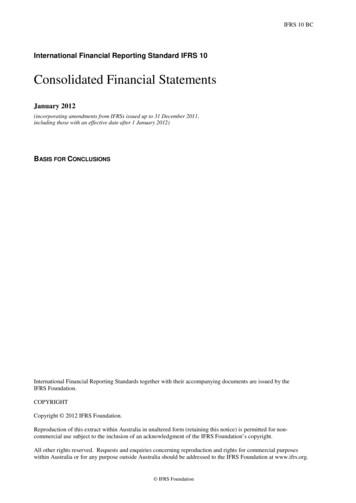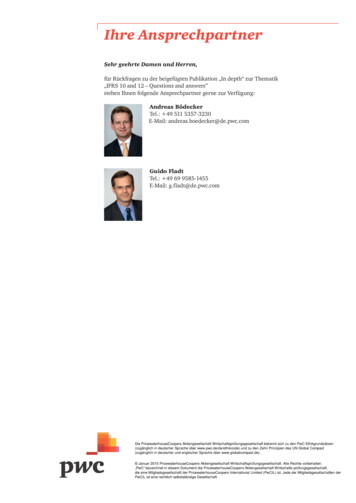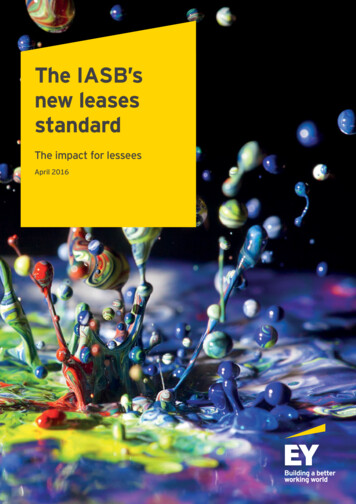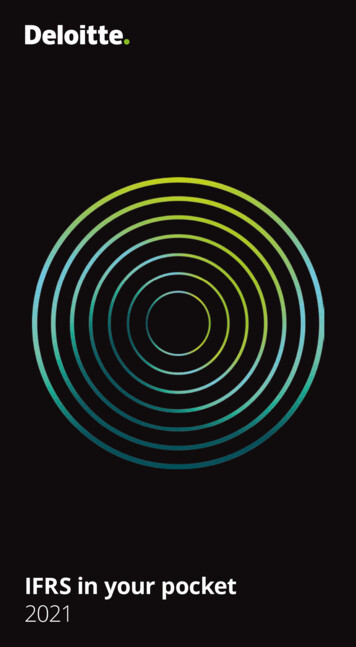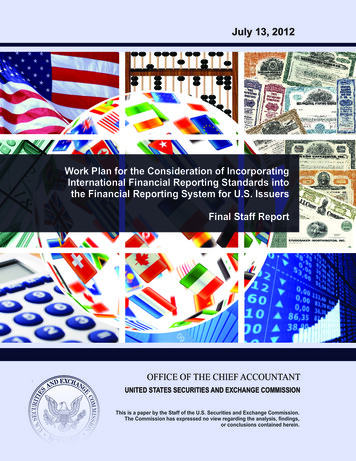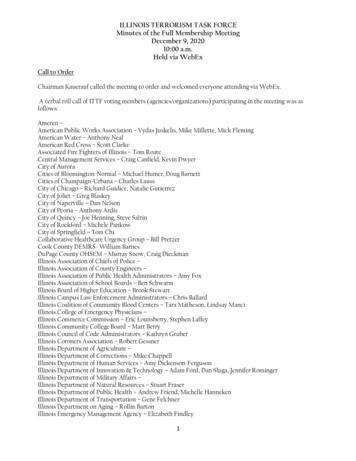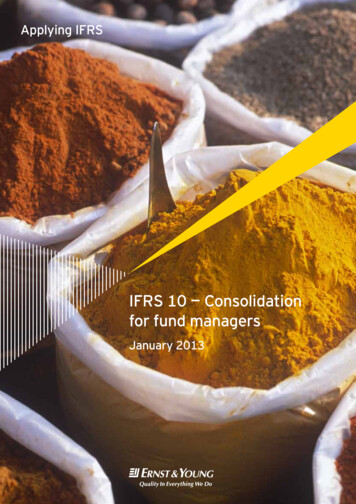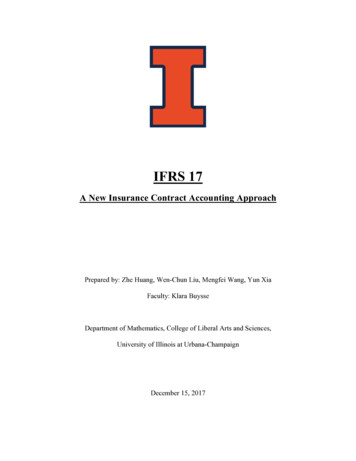
Transcription
IFRS 17A New Insurance Contract Accounting ApproachPrepared by: Zhe Huang, Wen-Chun Liu, Mengfei Wang, Yun XiaFaculty: Klara BuysseDepartment of Mathematics, College of Liberal Arts and Sciences,University of Illinois at Urbana-ChampaignDecember 15, 2017
Abstract:The IASB issued IFRS 17[1], a comprehensive new accounting standard for insurance contractscovering recognition and measurement, presentation and disclosure. Insurance companies need toadapt the IFRS 17 standards to his insurance contracts and financial statements before 1 January2021. In this research, we looked into the IFRS 17 standards, developed a term life insurancecontract model, and applied the IFRS 17 standards to this contract. Result suggested that themodification from IFRS 4 to IFRS 17 mainly focused on the following measurements:a)b)c)d)e)Estimation of future cash flows;Discount rate;Risk adjustment for non-financial risk;Contractual service margin, andSubsequent measurementTable of Content:I. IntroductionII. IFRS History and Background2.1 IFRS Foundation and Background2.2 Benefits of Reporting Under IFRS 172.3 Major Difference Between IFRS 17 and Solvency IIIII. IFRS Interpretation3.1 Scope and Feature3.2 Measurement Models3.3 Recognition3.4 Estimate of Future Cash Flows3.5 Discounting3.6 Risk Adjustment for Non-Financial Risk3.7 Contractual Service MarginIV. IFRS Illustrative Example4.1 Assumptions4.2 Calculation4.3 Accounting IllustrationV. Limitation and Future Research ImplicationVI. Appendix
I. IntroductionIFRS is defined as International Financial Reporting Standards1. It is issued by the InternationalFinancial Reporting Standards Foundation (IFRS Foundation) and the International AccountingStandards Board (IASB). IFRS acts on entity accounts, and provides a global language to makeaccounts comparable and legible to different countries. Currently, countries report under IFRSreporting systems are using IFRS 4 for insurance contracts.IASB issued the IFRS 17 standards on May 17, 2017. As a result of the change, insurancecompanies will need to comply with the IFRS 17 standards by January,1 2021. Many countriesadopt IFRS as their official accounting standards, such as South Korea, European Union, Australia,Hong Kong. The United States does not adopt IFRS as accounting standards, but uses US GAAPfor domestic accounting practices, while they do follow IFRS for companies with subsidiaries inother countries. By adapting IFRS 17, insurer will become truly comparable across most nationalboundaries, and will be more informed for portfolio choices.In this investigation, we evaluate the IFRS 17 Standard, apply it to a term insurance, and comparethe results with the previous accounting practices. The goal is to understand the IFRS 17 standardsand to build a small insurance company in order to discuss the effect of IFRS 17.II. IFRS 17 Background2.1 IFRS Foundation and IFRS SystemThe IFRS Foundation is a non-profit international organization that is responsible for developinghigh quality, understandable, enforceable, and globally accepted accounting standards, known asIFRS Standards2. Before the establishing of IFRS Foundation and the issue of IFRS Standards,insurance companies from different countries used independent and unstandardized accountingprinciples for financial reporting. IFRS Foundation beliefs that “High-quality financialinformation is the lifeblood of capital markets”. By providing standardized accounting principlesthat companies should follow when preparing and publishing the financial statement, IFRS provides a standardized way for companies to describe financial performance. Publiclyaccountable companies and financial institutions are legally required to publish their financialreports in accordance with the agreed accounting standards for some jurisdictions. IFRS Foundation aims to bring transparency, accountability, and efficiency to financial markets aroundthe world by developing the IFRS Standards. IFRS Foundation serves the public interest byfostering trust, growth, and long-term financial stability in the global economy by enhancinginternational comparability, reducing the information gap between capital providers and investors,helping investors to identify opportunities and risks across the world3.IFRS Standards have already been widely accepted around the world. According to the officialwebsite of IFRS (ifrs.org), IFRS Foundation have completed profiling for 150 jurisdictions,including all of the G20 jurisdictions. The total 150 jurisdictions represent all parts of the globe,29% from Europe, 15% from Africa, 9% from the Middle East, 22% from Asia and Oceania, 25%from Americas. About 84% of the IFRS recorded profiles require IFRS Standards for all or most1“IFRS 17 Standards”. ards/ifrs-17-insurance-contracts/“IFRS.org”. http://www.ifrs.org/about-us/who-we-are/3“Why global accounting standards”. l-accounting-standards/2
domestic publically accountable entities in their capital market. The 150 profiled jurisdictionsrepresent 98.6% of the world’s GDP (2015 data), and 47.5% of the profiled jurisdictions GDPrequire IFRS Standards for all or most domestic Publicly Accountable Entities (PAEs). IFRSStandards enhance the global comparability by providing standardized accounting principles. Eventhough United States still report under U.S. GAAP, some United State multination corporation hasalready used IFRS standards for their foreign subsidiaries4.2.2 Benefits of Reporting under IFRS 17Currently, jurisdictions that are reporting under IFRS Standards, apply IFRS 4 InsuranceContracts on insurance contracts. IFRS 4 is a standard issued in March 2004 by the InternationalAccounting Standards Board (the Board). IFRS 4 applies to entities which have:-insurance contracts (including reinsurance contracts) and reinsurance contracts (IFRS 4-2(a));financial instruments with a discretionary participation feature.According to IFRS.org, IFRS 4 is an interim standard resulting from phase I of the Board’s activeproject on insurance contracts and is intended to apply only until the entities adopt IFRS 17.Currently, the lack of consistency in IFRS 4 leads to the situation that different countries are usingdifferent accounting practices. However, IFRS 17 requires that all insurance contract will have touse the same accounting treatment. This will be beneficial for the insured and the insurancecompany. Thus, IFRS 17 will increase the transparency and more comparability. IFRS 17 usespresent value rather than historical cost to calculate insurance obligation. IFRS 17 will have asignificant effect on financial, actuarial field.IFRS 17 is effective for annual reporting periods beginning on or after January,1 2021. Currently,IFRS 17 is not publically available. It is currently available only to ifrs.org Premium subscribers.The unaccompanied standard will be available to basic subscribers in early 2018. According to theifrs.org, IFRS 17 combines current measurement of the future cash flows with the recognition ofprofit of the period that services are provided under the contract; presents insurance service results(including presentation of insurance revenue) separately from insurance finance income orexpenses; and requires an entity to make an accounting policy choice of whether to recognize allinsurance finance income or expenses in profit or loss or to recognize some of that income orexpenses in other comprehensive income. IFRS 17 measurement model emphasis best estimate offuture cash flows, time value of money(discounting), risk adjustment, and contractual servicemargin(CSM)5.More and more jurisdictions are adopting IFRS Standards as it is an internationalized standard thatprovides a consistent methodology in accounting and financial reporting. For countries that heavilyinvolved in international markets trading, IFRS Standards provides a system with globalcomparability and saves time and money that gave to accounting. More than one third of moderneconomics rely on international transactions, and the international transactions' weight is expectedto grow in the future. It is important to regulate the international trading, and provide atransparency environment for investors. Also, countries involved in international trading mightlose profits due to different countries maintaining their own national accounting standards. In45“The use of IFRS Standards around the world”. http://www.ifrs.org/use-around-the-world/“IFRS 17 Insurance Contracts”. ards/ifrs-17-insurance-contracts/
conclusion, it is necessary to set an international accounting standard to create a high quality,transparent, equitable calculation basis for different countries.For investors, IFRS standards provide transparency by increasing the cross-countriescomparability and having high quality of financial information. IFRS standards also provideequitable by using same calculation basis to reduce the difference between national accountingstandards. Thus, they enhance the impartiality when investors judging opportunities and riskinternationally.For entities, the IFRS can prove a credible globally accepted accounting language. IFRS reducesinternational reporting cost by unifying business transaction, thus improves market efficiency. Thereason for which is, in the long run, that the single set of national accounting standards will wastetime and consume more cost for preparing the international accounting reports. Using IFRS willreduce the preparing time and cost, and regulate the international trading.IFRS 17 reduces reporting time by decreasing the number of companies that use the GAAP bases,and it reduces the reporting cycle by automation. IFRS 17 also increases the planning, estimate,and management quality and speed thus it can increase expanding speed for international markets.From the management side, IFRS 17 let insurance companies proactively manage the business bycompleting consistent reports for all entities, hence improves risk rating. Insurance companies canuniform internal reporting and external reporting by having these benefits.As entities, using IFRS will better manage accounting and finance information at the same time.Entities will also measure itself with international peers on same accounting basis.2.3 Major difference between IFRS 17 and Solvency IISolvency II, is a formula-based law that regulates especially EU insurance companies. SolvencyII came into force on January 1, 2016. As IFRS 17 will also be adopted by European countries.The IFRS 17 affects all insurance, reinsurance contract, and investment with discretionaryparticipation features (only for companies issuing insurance contract). However, Solvency IIaffects all contracts regulated as insurance. When doing accounting contract components, IFRS 17separate non-insurance components from insurance components, while Solvency II requires lessseparation due to its demand of market consistent valuation for all assets and liabilities. IFRS 17and Solvency II provide two different Definition of Contract Boundary. IFRS 17 states that entitiesdon't have rights to receive premiums or obligations to provide service, however, Solvency II statesentities have the one-sided right to dissolution the contract.The difference between IFRS 17 and Solvency II is that IFRS 17 provides less detailed informationfor the calculation. For example, cash flows in IFRS 17 would incur to fulfil a group of contracts,and Solvency II cash flow projection includes all cash inflows and cash outflows. Unlike SolvencyII, IFRS 17 does not allow overhead cash flows. IFRS 17 requires entities discount the insuranceliabilities by using top-down and bottom-up approach without specific rate. However, Solvency IIunequivocal require yield curve to calculate the discounting, which published by the EuropeanInsurance and Occupational Pensions Authority (EIOPA). For the risk adjustment part, IFRS 17required two main type of risk adjustment, which not provided a specific calculation. Under theSolvency II, entities calculating the risk margin aligns with the Cost of Capital method. However,entities have the potential to prefer another method under IFRS 17.
III. IFRS 17 Interpretation3.1 Scope and FeatureIFRS 17 applies to:3(a) insurance contracts, including reinsurance contracts, it issues;(b) reinsurance contracts it holds; and(c) investment contracts with discretionary participation features it issues, provided theentity also issues insurance contracts5.IFRS 17 does not apply to:7(a) warranties provided by a manufacturer, dealer or retailer in connection with the saleof its goods or services to a customer (see IFRS 15 Revenue from Contracts withCustomers).(b) employers’ assets and liabilities from employee benefit plans (see IAS 19 EmployeeBenefits and IFRS 2 Share-based Payment) and retirement benefit obligations reported bydefined benefit retirement plans (see IAS 26 Accounting and Reporting by RetirementBenefit Plans).(c) contractual rights or contractual obligations contingent on the future use of, or theright to use, a non-financial item (for example, some licence fees, royalties, variable andother contingent lease payments and similar items: see IFRS 15, IAS 38 Intangible Assetsand IFRS 16 Leases).(d) residual value guarantees provided by a manufacturer, dealer or retailer and alessee’s residual value guarantees when they are embedded in a lease (see IFRS 15 andIFRS 16).(e) financial guarantee contracts, unless the issuer has previously asserted explicitly thatit regards such contracts as insurance contracts and has used accounting applicable toinsurance contracts. The issuer shall choose to apply either IFRS 17 or IAS 32 FinancialInstruments: Presentation, IFRS 7 Financial Instruments: Disclosures and IFRS 9Financial Instruments to such financial guarantee contracts. The issuer may make thatchoice contract by contract, but the choice for each contract is irrevocable.(f) contingent consideration payable or receivable in a business combination (see IFRS 3Business Combinations).(g) insurance contracts in which the entity is the policyholder, unless those contracts arereinsurance contracts held (see paragraph 3(b))5.According to IFRS 17 Contract 8(a) to 8(c), Entity should apply IFRS 15 instead of IFRS 17 if:8(a) entity does not reflect an assessment of the risk with individual consumers;(b) providing services rather than making cash payments;(c) insurance risk transferred from consumer's use of services rather than cost of thoseservices5.IFRS 17 aimed to show financial position and result for the reporting period, the scope includesrecognition, measurement, presentation and disclosure of insurance liabilities. The Scope of IFRS17 includes entities of insurance contract, reinsurance contract, and investment contract. Withmore information being disclosed in insurance companies’ financial statements, investors will bemore informed on the characteristics, risk nature, amount, timing, and uncertainty of future cashflow from insurance contracts with in the scope of IFRS 17.
3.2 Measurement ModelsThere are three measurement models used in IFRS 17. They are: General model (building blockapproach), variable fee approach (VFA) and premium allocation approach (PAA)6.(Left to right: Building Block Approach, Premium Allocation Approach, Variable fee approach)The general model, building block approach, is the default approach. It should be applied to allinsurance contracts, unless they have direct participation feature, or eligible for PAA method. Itusually applied on endowments, term life, whole life insurance. The technical provisions can besimply interpreted as four steps: estimate future cash flow, discount back to present value, adjustfor the risk and calculate contractual service margin. The building block approach discounts cashflow with an allowance for risk, and consistently valued options and guarantees. It uses a discountrate reflects insurance contract cash flow characteristics. It recognizes profit and loss as acontractual service margin over the contract term.The variable fee approach applied on contracts directly linked to underlying assets, such as unitlinks and certain participating contracts. The technical provision of VFA is similar to BuildingBlock Approach. After the initial recognition, VFA recognizes fair value of underlying assets, andmeasures shares of future value of underlying assets and fulfillment cash flows that do not vary onreturns, and discount to present value. The following process of risk adjustment and contractualservice margin process is the same as building block approach. Variable It is designed to deal withparticipating business where the liability is tied to underlying items. It reflects the link tounderlying returns for contracts that participate in a clearly pool of underlying items, where policyholders are paid a substantial share of the returns and a substantial proportion of the cash flowsvary with the underlying terms. This approach cannot measure reinsurance contracts. Under thismethod, the adjustments to the CSM use current discount rate. Notably that changes in insurers’share of assets recognized in CSM, and the profit or loss movement in liabilities mirrors treatmenton underlying assets.The premium allocation method is an optional method that used on short term contracts and preclaim period, such as 1-year non-life, health insurance, short-term group contracts. It is an optionalsimplified model that allowed for contracts that have a short duration. It is able to be applied to6“In depth, a look at current financial reporting issues.” PwC
measure the pre-claims liability, and the building block approach is applied for measuring incurredclaims.3.3 RecognitionAccording to IFRS 17 standard, an entity should recognize a group of insurance contract from theearliest date of the following:(a) the beginning of the coverage period of the group of contracts;(b) the date when the first payment from a policyholder in the group becomes due; and(c) for a group of onerous contracts, when the group becomes onerous5.The carrying amount of insurance contracts can be express as:Fulfillment cash flow Contractual Service Margin(CSM),this equation can be furthermore express as(Discount (Estimate of Future Cash Flow) Risk Adjustment) CSMwith the first two terms combined equal to Fulfillment cash flow3.4 Estimate of Future Cash FlowsThere are several principles entities should have followed when they are estimate the future cashflows. First, they should consider all reasonable information and apply probability-weighed meanof all possible outcomes to calculate the estimates of future cash flows. For example, if thepremium is 100, but the probability the policyholder will pay the premium is only 40%, then theestimate future cash flow is 40.Second, the estimated of market variables should be consistence with their observable marketprice. The market variables are variables that can be observe from market, for example, interestrate. As a result, the estimated of interest rate the entity use when estimating future cash flowshould be consistence with observable market interest rate price.Furthermore, the estimate of future cash flows also should be current and explicit. The former oneimplies the estimate should reflect existing conditions and latest assumptions about the future ateach measurement date while the latter one means the estimate should separately from theadjustment for the time value of money and financial risk.Besides, there are two levels of aggregation. The entity can either estimate the future cash flowindividually for each insurance contract, or aggregately for some insurance contracts first thenallocate to individual contract, if the insurance contracts are subject to similar risks, for examplecontracts within a product line, and are not issued more than one year apart from each other.However, entities should always follow paragraph 16 when they are determining insurancecontracts portfolio:16An entity shall divide a portfolio of insurance contracts issued into a minimum of:(a) a group of contracts that are onerous at initial recognition, if any;(b) a group of contracts that at initial recognition have no significant possibility ofbecoming onerous subsequently, if any; and(c) a group of the remaining contracts in the portfolio, if any5.
If the future cash flow is estimated individually, according to paragraph 34, the entity should onlyconsider the cash flow resulted from the rights that they can forced the policyholder to pay thepremium or from the obligations that the entity has to provide service. That is to say, the investincome and cash flow raised from reinsurance contracts should not be included.3.5 DiscountingDiscount an adjustment that converts future cash inflows and outflows into the present value. Anentity shall use discount rates on measure the fulfillment cash flows to adjust the carrying amountof the liability, and the amount of the insurance finance income or expense included in profit orloss that entity chooses to disaggregate insurance finance income or expenses between profit orloss. General insurers feel that an allowance for illiquidity in the IFRS 17 discount rate isappropriate in some cases, especially for long tail liabilities. Because that provide a more realisticvaluation of insurance liabilities (IFRS 17 insurance contracts, section B72).Discount rates (paragraphs B72–B85)36An entity shall adjust the estimates of future cash flows to reflect the time value of moneyand the financial risks related to those cash flows, to the extent that the financial risks arenot included in the estimates of cash flows. The discount rates applied to the estimates ofthe future cash flows described in paragraph 33 shall:(a) reflect the time value of money, the characteristics of the cash flows and the liquiditycharacteristics of the insurance contracts;(b) be consistent with observable current market prices (if any) for financial instrumentswith cash flows whose characteristics are consistent with those of the insurance contracts,in terms of, for example, timing, currency and liquidity; and(c) exclude the effect of factors that influence such observable market prices but do notaffect the future cash flows of the insurance contracts5.IFRS 17 Standard introduce the idea of discount rate to insurance accounting to reflect the timevalue of money and the financial risk like liquidity risk that related to those entities. The discountrate is required to reflect the time value of money, the liquidity characteristic of insurance contracts,and the characteristics of the cash flow like maturity and duration. It should also be consistent withobservable current market rate or return for financial instrument with cash flows that have similarcharacteristics with those of the insurance contracts in terms of timing, liquidity, maturity andduration. It should also exclude the factors that influence the observable market rate of return likecredit risk, but do not affect the future cash flows of the insurance contracts.B84In principle, for cash flows of insurance contracts that do not vary based on the returnsof the assets in the reference portfolio, there should be a single illiquid risk-free yield curvethat eliminates all uncertainty about the amount and timing of cash flows. However, inpractice the top-down approach and the bottom-up approach may result in different yieldcurves, even in the same currency. This is because of the inherent limitations in estimatingthe adjustments made under each approach, and the possible lack of an adjustment fordifferent liquidity characteristics in the top-down approach. An entity is not required toreconcile the discount rate determined under its chosen approach with the discount ratethat would have been determined under the other approach5.From the IFRS 17 Standards, the discounting process deals with two kind of cash flows. Insurancecash flows not directly related to assets and insurance cash flows directly related to assets. To
discount the insurance cash flows that are not directly linked to assets, IFRS 17 suggested twoapproaches:-Bottom-upTop-down approachB74(b) Cash flows that very based on the returns on any financial underlying items shall bediscounted using rates that reflect the variability; or adjusted for the effect of that variabilityand discounted at a rate that reflects the adjustment made5.The bottom-up approach firstly determines a risk-free yield curve in appropriate currency, thenadjusts for liquidity premium of the insurance contract comparing to similar financial instrumentpublically available in the market. The liquidity premium adjustment reflects the risk thatinsurance contracts holds the liquidity of cash flow is not fixed due to policyholders may terminatecontract and only subject to surrender penalties, or cannot terminate contract at all.The top-down approach uses a yield curve that reflects the current market rate of return implicit ina fair value measurement of a reference portfolio of assets, while adjusted to eliminate cost of risktaken that are not relevant to the insurance contracts, which is not relevant for insurance contract.It usually uses market rate of return of a reference portfolio of assets minus default adjustmentminus cost of downgrade. It adjusts the effect of variability and reflects in discount rate7.There are three types of liability cash flows. One is not-liquid liabilities, for example, annuitiesand single premium terms. Not-liquid liabilities has no surrender risk and only risks are longevityrisk and expense risk, and the premiums have been paid. The Bottom-up approach to calculate notliquid liabilities is the swap yield curve plus the liquidity premium. Second is the Semi-liquidliabilities, for example, endowments and terms. It has some surrender risk, other liquidityindicators include mortality, longevity, morbidity, expense risk, and premium is not all paid. Thebottom-up approach need to adjust the interest rate with swap yield curve plus some portion of theliquidity premium. The last kind of liabilities is liquid liabilities like unit links that has substantialsurrender risk and no longevity risk. The Bottom up approach need to use the swap yield curveappropriate to the currency of the related cash flows. All these kinds of liabilities can find discount7“Introduction to IFRS 17.” 3Blocks, http://www.3blocks.co/documents/materials/3Blocks IFRS%2017.pdf
rate by top-down approach by using government bonds curve less credit risk like probability ofdefault and cost of downgrade.In practice, the top-down approach and the bottom-up approach may result in different yield curves.The inherent limitation in estimating the adjustments made under each approach, and the possiblelack of adjustment for different liquidity characteristics in different approach can be the cause ofthe differences.3.6 Risk Adjustment for Non-Financial RiskRisk adjustment for non-financial risk is the risk other than financial risk in insurance contracts.Financial risk has already been considered in the estimate of future cash flows and discounting.The financial risk and non-financial risk should be separated, and the entity should not count themtwice in the risk adjustment process.Risk adjustment is necessary because of uncertainty. For example, an entity has its own life tablebased on its historical data, but the data may not be exactly correct for the product since themortality table is only a prediction. The policyholders may live shorter or longer than expected,which places mortality risk and longevity risk on the entity. Risk adjustment makes sure that theentity is able to afford these risks if they happen.The risk adjustment for non-financial risk measures the compensation required to make the entityindifferent between fulfilling a liability that has multiple possible outcomes and a liability that willgenerate fixed cash flows. For example, if the entity has a liability of 110, and another liabilitythat has a 50% probability to be 100 and a 50% probability to be 120, the compensations forthese two liabilities must be the same. As a result, the risk adjustment for non-financial risk givesthe information about how much the insurer charges for the uncertainty of future cash flows. Italso reflects the degree of diversification and risk aversion.There are two main types of risk adjustment. First, insurance contracts need to be adjusted tocompensate for bearing the uncertainty about the amount and timing of the cash flows that arisesfrom non-financial risk. Second, reinsurance contracts held also need to be adjusted to represent
the risk being transferred by the holder of the group of reinsurance contracts to the issuer of thosecontracts. In the balance sheet, both assets and liabilities will be adjusted.Under IFRS 17, risk adjustment is also the discounted cost of capital at risk free rate. However,IFRS 17 does not specify the method to calculate the risk-adjustment for non-financial risk, but itsets some requirements for risk adjustment: Risks with low frequency and high severity needs a higher risk adjustment than risks withhigh frequency and low severity.Risks with a longer duration will result in a higher risk adjustment than risks with a shorterduration.Risks with a larger volatility needs a higher risk adjustment than risks with a lowervolatility.Risk adjustment has to be higher for less known information about current estimate.An entity should apply judgement when measuring the risk adjustment for non-financial risk. It isalso important for the entity to provide concise and informative disclosure when applying thejudgement so that the users of financial statements can compare the performance of the entity withthe performance of other companies.3.7 Contractual Service MarginContractual service mar
IFRS is defined as International Financial Reporting Standards1. It is issued by the International Financial Reporting Standards Foundation (IFRS Foundation) and the International Accounting Standards Board (IASB). IFRS acts on entity accounts, and provides a global language to mak
